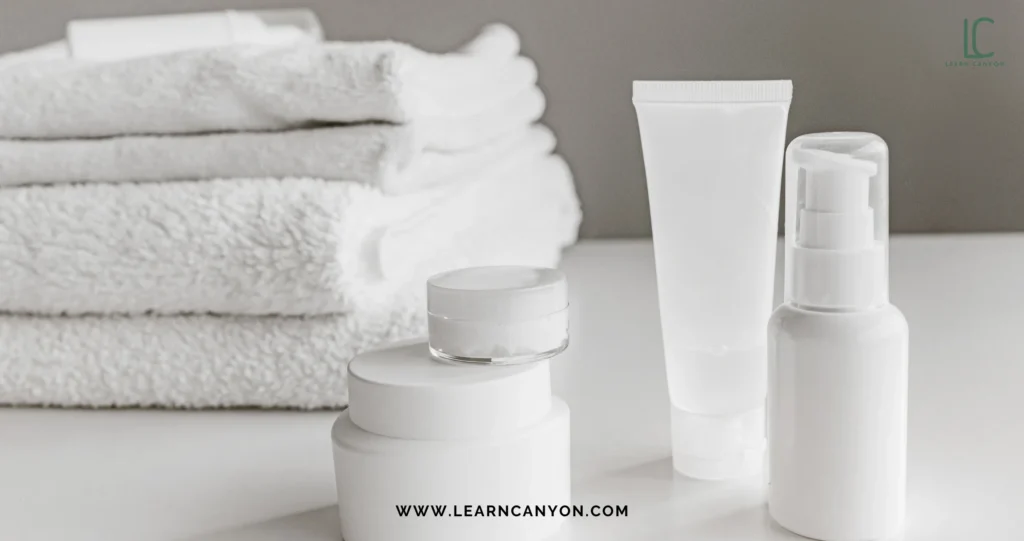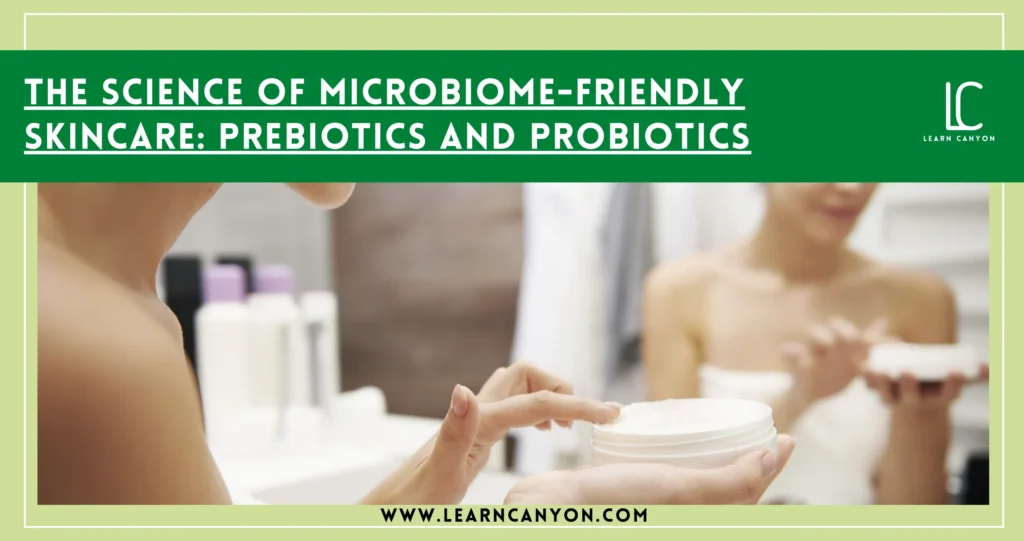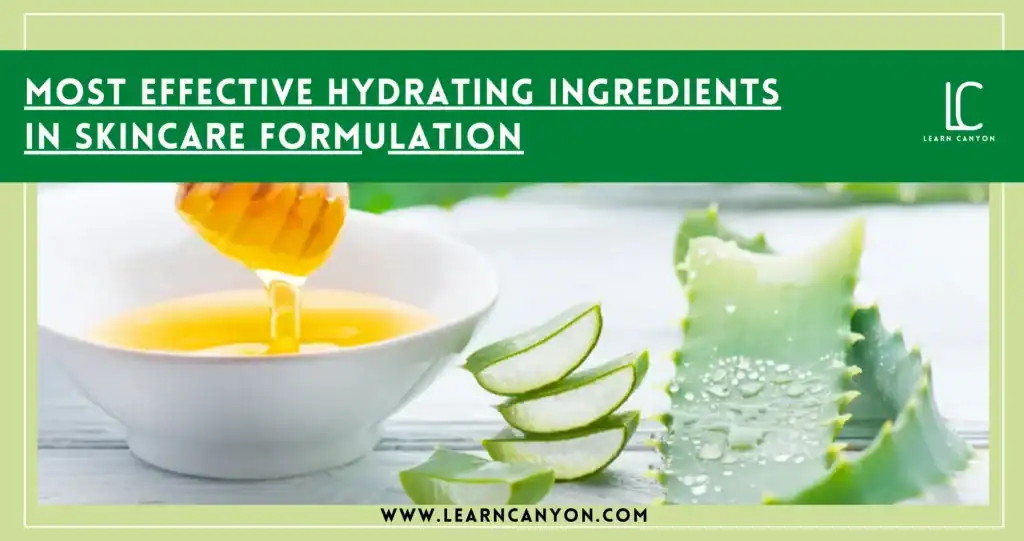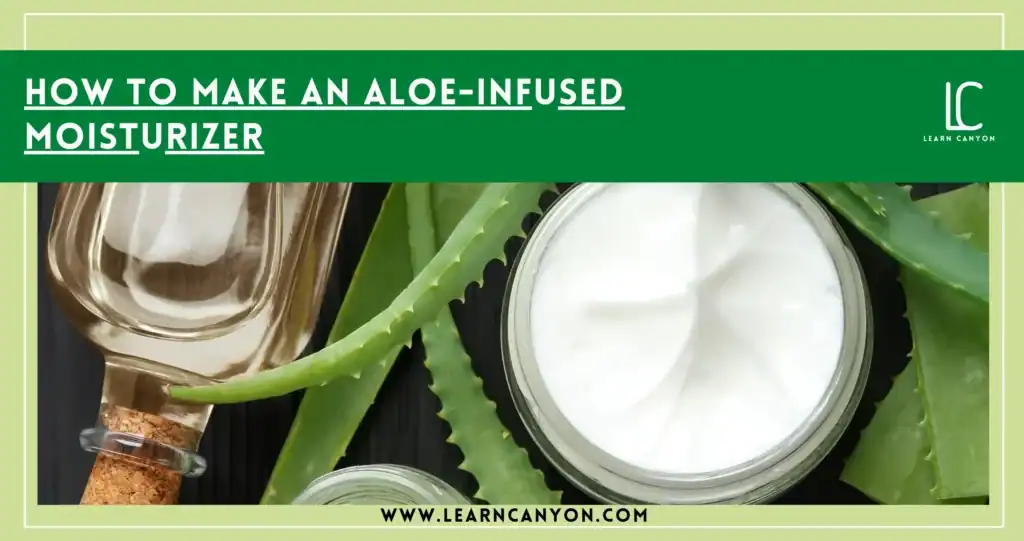Imagine your skin as a bustling ecosystem, teeming with billions of microorganisms working tirelessly to keep it healthy, balanced, and glowing.
This invisible community of bacteria, fungi, and other microbes is known as your skin microbiome, and it plays a critical role in maintaining your skin’s health and resilience.
However, factors like harsh skincare products, pollution, stress, and even diet can throw this delicate balance off, leaving your skin vulnerable to issues like dryness, sensitivity, breakouts, or premature aging.
As a professional formulator, I’ve witnessed a growing shift in skincare, a shift that embraces not just what you see on the surface, but what’s happening beneath it.
Microbiome-friendly skincare is no longer just a trend; it’s a scientifically-backed approach that acknowledges the profound connection between your skin’s microbiome and its overall health.
This is where prebiotics & probiotics step into the spotlight. Prebiotics act as nourishment for your skin’s beneficial microbes, while probiotics introduce friendly microorganisms to help restore and strengthen your microbiome. Together, they create a harmonious environment that supports healthy, radiant skin.
In this blog, we’ll dive deep into the science of microbiome-friendly skincare, explore the magic of prebiotics and probiotics, and discuss how these powerhouse ingredients can transform your routine.
Whether you’re curious about the science or looking to choose the right products, this guide will provide you with the insights you need to take your skincare to the next level.
Let’s get started!
What Is the Skin Microbiome?
Think of your skin as its own universe, an intricate ecosystem that’s home to trillions of microorganisms, including bacteria, fungi, and even viruses. While this might sound unsettling at first, the truth is, these tiny inhabitants play an essential role in keeping your skin healthy, balanced, and protected.
As a professional formulator, I like to describe the skin microbiome as your skin’s built-in defense team. It acts as a shield, protecting you from harmful pathogens while working behind the scenes to maintain hydration, regulate oil production, and reduce inflammation. This dynamic microbial community ensures your skin’s barrier stays intact and resilient.
However, this delicate balance can easily be disrupted. Factors like over-exfoliation, harsh cleansers, pollution, and even stress can tip the scales, leading to common issues such as dryness, sensitivity, acne, or eczema. When your microbiome is out of sync, your skin’s ability to repair and protect itself is compromised.
The exciting part is that with the right approach, you can help restore and nurture this microbiome for healthier, glowing skin. By incorporating microbiome-friendly skincare products formulated with prebiotics, probiotics, or both you’re essentially feeding and fortifying this microbial ecosystem.
Understanding and caring for your skin microbiome isn’t just another skincare buzzword. It’s a science-backed approach that’s revolutionizing how we think about skincare, shifting the focus from treating symptoms to creating long-term balance and resilience.

Prebiotics vs. Probiotics in Skincare
When it comes to microbiome-friendly skincare, two buzzwords often steal the spotlight: prebiotics and probiotics. You might already be familiar with these terms from your yogurt or gut health discussions, but did you know they play a transformative role in skincare too? Let me break it down for you.
What Are Prebiotics?
Think of prebiotics as the food your skin’s beneficial microbes need to thrive. They’re not living organisms themselves but rather the “fertilizer” that helps good bacteria flourish and maintain dominance over harmful microbes.
In skincare, prebiotics are typically derived from natural sugars, fibers, or plant extracts. Ingredients like inulin, alpha-glucan oligosaccharide, and oat beta-glucan are popular prebiotics you’ll often find in microbiome-friendly formulations. By nourishing your skin’s natural flora, prebiotics help to:
- Strengthen your skin barrier.
- Enhance hydration and resilience.
- Keep the microbiome balanced, reducing sensitivity and breakouts.
Using prebiotics is like planting seeds in a garden and making sure they get the water and nutrients needed to grow.
What Are Probiotics?
Now, let’s talk about probiotics the actual “living organisms” you’re introducing to your skin. These beneficial microbes are like reinforcements for your skin’s natural microbiome. They can help restore balance, reduce inflammation, and even produce antimicrobial peptides that fend off bad bacteria.
In skincare, probiotics often come in the form of lysates, ferments, or extracts, such as lactobacillus ferment or bifida ferment lysate. While they’re technically not “alive” by the time they’re in your skincare product, they still provide potent benefits:
- They calm irritated skin by supporting the skin’s repair process.
- Reduce redness and inflammation, making them great for sensitive or acne-prone skin.
- Help restore balance, especially if your microbiome has been disrupted by harsh cleansers or environmental stress.
Think of probiotics as introducing skilled workers into your ecosystem they know what needs to be done and get to work repairing and reinforcing your skin.
The Magic of Synbiotics
Here’s where it gets even more interesting: the combination of prebiotics and probiotics, known as synbiotics, can create a powerhouse formula. When used together, they work synergistically to amplify their benefits, nourishing your microbiome while reinforcing it at the same time.
Prebiotics or Probiotics: Which Do You Need?
The answer depends on your skin’s current condition:
- If your skin feels dry, sensitive, or inflamed, probiotics can help soothe and repair.
- If your skin seems imbalanced or prone to breakouts, prebiotics can encourage beneficial microbes to take over.
- For comprehensive support, look for products that combine both prebiotics and probiotics to deliver maximum benefits.
By understanding the difference between these two, you can make smarter choices for your skincare routine.
As a formulator, I’ve seen firsthand how incorporating prebiotics and probiotics into formulations transforms skin health not just treating issues, but creating long-term balance and resilience.
Whether you’re dealing with sensitivity, acne, or just want a radiant glow, these microbiome-friendly ingredients are a game-changer for your routine.
How Prebiotics & Probiotics Benefit the Skin
Let’s get straight to the point: prebiotics and probiotics are not just trendy ingredients, they’re game-changers for your skin. These powerhouse ingredients work from the inside out to create a balanced, resilient, and healthy complexion. But what exactly do they do, and why should they be part of your skincare routine?

Let me break it down for you.
1. Strengthen the Skin Barrier
Your skin barrier is like a fortress, protecting you from external aggressors like pollution, UV rays, and harmful bacteria. Prebiotics and probiotics work together to reinforce this barrier by supporting the good bacteria that naturally live on your skin. A strong barrier means:
- Fewer breakouts and irritations.
- Better moisture retention.
- Less sensitivity to harsh environments.
Think of it like building an army of beneficial microbes that defend your skin from anything trying to disrupt its peace.
2. Calm Inflammation and Sensitivity
If you’ve ever struggled with redness, irritation, or flare-ups, your skin might be crying out for balance. Probiotics release calming compounds, such as antimicrobial peptides, which can soothe irritation and reduce inflammation. Prebiotics, on the other hand, feed the good bacteria that help keep your skin calm and happy. Together, they’re a dream team for:
- Eczema-prone or rosacea-prone skin.
- Reducing redness and irritation.
- Supporting post-treatment recovery (like after exfoliation or peels).
3. Balance Oil Production
Struggling with oily or combination skin? Probiotics help regulate sebum production by balancing your microbiome. When harmful bacteria are kept in check, your skin’s oil production stabilizes naturally, leading to:
- Fewer clogged pores.
- Reduced shine without over-drying.
- A more even skin texture.
Prebiotics also play a role here, ensuring that your skin’s beneficial microbes get the nourishment they need to outcompete acne-causing bacteria.
4. Improve Hydration and Elasticity
Healthy, hydrated skin starts with a balanced microbiome. Probiotics boost the production of ceramides, which are essential for locking in moisture and maintaining skin elasticity. Prebiotics enhance this effect by feeding the bacteria that help produce these skin-replenishing compounds. The result?
- Plump, hydrated skin.
- A smoother texture and reduced fine lines.
- A natural glow that says, “I woke up like this.”
5. Support Skin Repair and Renewal
Your skin has a natural ability to repair itself, but it needs the right environment to do so effectively. Probiotics help stimulate skin renewal by encouraging healthy cell turnover and strengthening the barrier function. Prebiotics support this process by nourishing the microbial balance needed for optimal repair. This means:
- Faster healing of blemishes and minor irritations.
- Reduced appearance of scars and pigmentation.
- Healthier, more resilient skin over time.
6. Defend Against Environmental Stress
Every day, your skin faces stressors like pollution, UV damage, and harsh weather. Probiotics act like a shield, neutralizing harmful bacteria and free radicals, while prebiotics ensure your skin’s natural defenses remain strong. Together, they help your skin adapt and recover from environmental assaults.
When prebiotics and probiotics are part of your skincare routine, you’re not just addressing surface-level concerns you’re supporting your skin’s ecosystem for long-term health. Whether you’re dealing with breakouts, dryness, or sensitivity, these ingredients help your skin find its natural balance, leaving it healthier, stronger, and more radiant.
Popular Ingredients in Microbiome-Friendly Skincare
When it comes to microbiome-friendly skincare, the ingredients list is where the magic happens. As a professional formulator, I often get excited about the range of ingredients that can help support and balance the skin’s microbiome. These aren’t just trendy names they’re carefully chosen for their ability to nourish good bacteria, calm irritation, and reinforce the skin’s barrier. Let’s take a closer look at some of the superstars in microbiome-friendly formulations.
1. Prebiotic Ingredients
These are the “food” for your skin’s beneficial microbes. They ensure the good bacteria thrive while keeping harmful microbes in check.
- Inulin: Derived from chicory root, this natural sugar feeds your skin’s beneficial bacteria, helping to maintain balance and improve hydration.
- Alpha-Glucan Oligosaccharide: A prebiotic powerhouse that boosts your skin’s natural defense system and enhances resilience against external stressors.
- Oat Beta-Glucan: Known for its soothing and hydrating properties, it doubles as a prebiotic to nourish the microbiome while calming sensitive skin.
- Fructooligosaccharides (FOS): Derived from fruits and vegetables, these sugars nourish your skin’s natural flora and improve its ability to hold moisture.
2. Probiotic Ingredients
These bring the good bacteria directly to your skin (or their beneficial byproducts) to restore and reinforce your microbiome.
- Lactobacillus Ferment: A widely used probiotic that supports skin barrier repair, soothes irritation, and reduces redness.
- Bifida Ferment Lysate: Known for its ability to repair and protect against environmental damage, it’s a favorite in microbiome-supporting products.
- Streptococcus Thermophilus Ferment: Enhances ceramide production, which is crucial for hydration and barrier strength.
- Saccharomyces Ferment Filtrate: A fermentation byproduct packed with antioxidants and amino acids that improve skin texture and resilience.
3. Postbiotic Ingredients
Postbiotics are the beneficial compounds produced during the fermentation process of probiotics. They offer antimicrobial and anti-inflammatory benefits while supporting skin health.
- Lactic Acid: While commonly known as an exfoliant, lactic acid is also a postbiotic that helps maintain a healthy pH and nourishes the skin microbiome.
- Peptides: Some peptides, like those derived from probiotic fermentation, help repair the skin barrier and boost cell communication for healthier skin.
- Kombucha Ferment: Packed with antioxidants and organic acids, it helps improve skin elasticity and tone while supporting the microbiome.
4. Hydrating and Soothing Allies
While not prebiotics or probiotics themselves, these ingredients complement microbiome-friendly formulations by keeping the skin hydrated and calm, creating an environment where good bacteria can thrive.
- Aloe Vera Extract: Known for its soothing properties, it’s a perfect companion to prebiotic and probiotic formulations.
- Chamomile Extract: A gentle anti-inflammatory that helps calm irritated or inflamed skin, making it microbiome-friendly.
- Hyaluronic Acid: Keeps the skin hydrated and plump, which is essential for maintaining a balanced microbiome.
5. Fermented Oils and Extracts
Fermentation enhances the bioavailability of nutrients in oils and extracts, making them more effective for the skin and its microbiome.
- Fermented Rice Water: Rich in amino acids and vitamins, it helps restore skin barrier function and promotes a healthy microbiome.
- Fermented Sea Kelp: Packed with minerals and antioxidants, it soothes the skin and supports its natural defenses.
- Fermented Green Tea: Offers enhanced antioxidant benefits, calming inflammation while protecting the microbiome.
How to Spot These Ingredients in Products
When choosing microbiome-friendly skincare, look for terms like “ferment,” “lysate,” or “oligosaccharide” on the label. Pair these with soothing, hydrating ingredients for a formulation that doesn’t just treat the surface of your skin but nurtures its invisible ecosystem.
Why These Ingredients Matter
Each of these ingredients works in harmony with your skin’s natural microbiome to promote balance, resilience, and long-term health. By incorporating products with these ingredients into your routine, you’re not just treating symptoms—you’re addressing the root cause of many common skin concerns.
As a formulator, I always strive to include these microbiome-supporting ingredients in my work because they truly deliver. Whether you’re dealing with sensitivity, dryness, or acne, or you just want that radiant glow, these ingredients are the foundation for a healthier, happier skin microbiome.
Challenges and Misconceptions in Microbiome-Friendly Skincare
Microbiome-friendly skincare has taken the beauty world by storm, and for good reason it’s rooted in science and delivers real benefits. But like any trend, it comes with its fair share of challenges and misconceptions. Let’s have an honest conversation about what you need to know so you can make informed choices.

1. “Are There Really Live Bacteria in My Skincare?”
This is one of the biggest misconceptions I come across. Many people assume that probiotic skincare means they’re applying live bacteria to their skin. While the idea might sound fascinating (or a little scary), the truth is that most probiotic ingredients in skincare are actually ferments, lysates, or extracts. These are byproducts of probiotics, not live organisms, and they deliver all the benefits without the stability issues of keeping bacteria alive in a product.
As a formulator, I can tell you that maintaining live probiotics in skincare is incredibly tricky. They require very specific conditions (temperature, pH, and preservation) to survive, which is why the focus is often on their beneficial byproducts instead.
2. Stability Issues with Probiotics
Probiotics are sensitive little powerhouses. Their effectiveness can diminish if a product isn’t formulated correctly or exposed to unfavorable conditions. Things like heat, air, and even the packaging can impact their stability.
This is why you’ll often see probiotics paired with stabilizing agents or used in forms like lysates or ferments, which are more resilient and effective in skincare formulations. It’s also a good reason to check expiration dates and store your products properly.
3. Misunderstanding Prebiotics and Probiotics
Here’s a common misconception: some people think prebiotics and probiotics do the same thing. They don’t. Prebiotics are like food for the good bacteria already on your skin, while probiotics help introduce or reinforce beneficial microbes. The magic really happens when you combine the two, as they work synergistically to nourish and balance your skin microbiome.
When shopping for microbiome-friendly skincare, look for products with both prebiotics and probiotics (or postbiotics) for maximum benefits.
4. “Microbiome-Friendly” Isn’t a Regulated Term
One of the challenges with microbiome-friendly skincare is the lack of regulation around the term. Brands can slap “microbiome-friendly” on their products without any real testing to back it up. Not every product claiming to support your microbiome is truly effective, which is why understanding the ingredients and their role is so important.
Pro tip as a formulator: Look for certifications like “microbiome-tested” or detailed explanations of how the product supports your skin’s microbiome. Brands that invest in research will often proudly share their testing methods.
5. Overcomplicating Your Routine
A lot of people think that to maintain a healthy microbiome, you need an entirely new skincare routine filled with prebiotics and probiotics. But that’s not true. In fact, less is more when it comes to microbiome-friendly skincare. Over-exfoliating, using harsh cleansers, or piling on too many active ingredients can actually harm your skin’s microbiome.
Start simple:
- Use a gentle cleanser with a balanced pH.
- Incorporate one or two microbiome-friendly products (like a serum or moisturizer).
- Avoid overuse of stripping ingredients like alcohols or aggressive exfoliants.
6. Thinking Probiotics Are a Quick Fix
Probiotics are amazing, but they’re not a magic wand. Restoring your skin’s microbiome takes time and consistency. It’s not about instant results it’s about creating balance and resilience in the long run.
If you’re dealing with conditions like acne or sensitivity, probiotics can help as part of a comprehensive routine, but they’re most effective when combined with other supportive ingredients like hydrators (hyaluronic acid) and barrier-strengthening compounds (ceramides, niacinamide).
7. Cost vs. Effectiveness
Microbiome-friendly skincare often comes with a premium price tag, which can lead people to assume that the more expensive the product, the better it is. That’s not always true. Effective microbiome-friendly formulations are more about ingredient quality and synergy than price. You don’t need to break the bank just look for products with proven ingredients like lactobacillus ferment, inulin, and bifida ferment lysate.
8. Overlooking Other Factors
One of the most overlooked challenges? Your lifestyle. Your skin microbiome is influenced by much more than just skincare. Diet, stress, and environmental factors all play a role in its health. For example:
- Eating prebiotic-rich foods (like bananas, oats, and garlic) can nourish your microbiome from within.
- Reducing stress helps prevent microbiome disruptions caused by cortisol spikes.
- Protecting your skin from pollution and UV damage supports a healthy microbial balance.
Microbiome-friendly skincare is an exciting, science-backed approach, but it’s not without its challenges and misconceptions. As a professional formulator, my advice is to be mindful, do your research, and start simple. Choose products that align with your skin’s needs and look for transparency from brands about their microbiome claims.
Above all, remember: caring for your microbiome isn’t about perfection—it’s about balance. And when you find that balance, your skin will thank you with strength, resilience, and a radiant glow!
Choosing Microbiome-Friendly Products
If you’re ready to embrace microbiome-friendly skincare, the first step is learning how to identify products that truly support your skin’s natural ecosystem. But with so many labels, claims, and trendy ingredients out there, it can get a little overwhelming. Don’t worry—I’ve got you covered! As a professional formulator, here’s how I recommend navigating the world of microbiome-friendly products.
1. Look for “Microbiome-Friendly” Certifications
One of the easiest ways to spot a product designed for your skin microbiome is to check for certifications or claims like “microbiome-tested” or “microbiome-friendly.” These labels often indicate that the product has undergone specific testing to ensure it supports, rather than disrupts, the skin’s microbial balance.
Pro tip: Not all products labeled “microbiome-friendly” are created equal dig into the details and check for transparency from the brand about their testing methods.
2. Check the Ingredients List
A good microbiome-friendly product will include key ingredients known to support your skin’s microbial balance. Here’s what to look for:
- Prebiotics: These nourish your skin’s existing good bacteria. Look for ingredients like inulin, alpha-glucan oligosaccharide, and fructooligosaccharides (FOS).
- Probiotics: These introduce beneficial bacteria or their byproducts to your skin. Common examples include lactobacillus ferment, bifida ferment lysate, and saccharomyces ferment.
- Postbiotics: These are the active compounds produced during probiotic fermentation, such as lactic acid or peptides, which calm and protect the skin.
If the product combines prebiotics and probiotics (often called synbiotics), you’ve got a winning formula!
3. Prioritize pH-Balanced Formulas
Your skin microbiome thrives in an environment with a slightly acidic pH (around 4.5 to 5.5). Products that are too alkaline can disrupt this balance, leading to dryness, irritation, and even breakouts.
When choosing products, look for ones that explicitly state they’re pH-balanced. If the pH isn’t listed, reach out to the brand most reputable companies are happy to provide this information.
4. Avoid Harsh Ingredients
Your skin microbiome is delicate, and certain ingredients can harm the beneficial bacteria that keep it balanced. Watch out for:
- Harsh sulfates (like sodium lauryl sulfate) that strip the skin of its natural oils.
- High concentrations of alcohol, which can dry out the skin and disrupt the microbiome.
- Synthetic fragrances and other irritants that can cause inflammation or sensitivity.
Instead, opt for gentle cleansers, moisturizers, and serums with soothing and hydrating ingredients like aloe vera, chamomile extract, and hyaluronic acid.
5. Consider Packaging
Probiotic and prebiotic ingredients can be sensitive to environmental factors like air, light, and heat. To ensure they stay effective, choose products with airless pumps, opaque bottles, or tightly sealed jars. Proper packaging protects these delicate ingredients and ensures you’re getting the full benefit with every use.
6. Start with One or Two Products
You don’t need to overhaul your entire skincare routine to embrace microbiome-friendly skincare. Start with one or two products, like a gentle cleanser and a serum or moisturizer. This lets you monitor how your skin reacts and ensures you’re not overwhelming it with too many new ingredients at once.
Some great places to begin:
- A microbiome-friendly cleanser to gently remove dirt and impurities without disrupting your skin’s pH.
- A probiotic serum to target specific concerns like redness, dryness, or breakouts.
- A prebiotic moisturizer to hydrate and nourish your skin barrier.
7. Understand Your Skin’s Needs
Not all microbiome-friendly products are designed for every skin type or concern. For example:
- Dry or sensitive skin benefits from soothing, hydrating ingredients like beta-glucan and probiotic ferments.
- Oily or acne-prone skin responds well to balancing ingredients like lactobacillus ferment and alpha-glucan oligosaccharide.
- If you’re dealing with redness or irritation, look for calming ingredients like bifida ferment lysate or chamomile extract.
Knowing your skin type and concerns helps you choose products that work harmoniously with your microbiome.
8. Be Patient and Consistent
Restoring your skin microbiome isn’t an overnight fix. It takes time for your skin to adjust to new products and for the microbiome to rebalance itself. Stick with your chosen products for at least 4–6 weeks before evaluating the results.
Choosing microbiome-friendly skincare is about more than just jumping on the latest trend it’s about nurturing your skin’s natural ecosystem for long-term health and radiance. By focusing on gentle, supportive ingredients, pH-balanced formulas, and smart packaging, you can create a routine that works with your skin, not against it.
As a formulator, I believe that microbiome-friendly skincare is one of the most exciting advancements in the beauty industry. When done right, it transforms not just your skin but your understanding of what it means to truly care for it. So, take it slow, trust the process, and watch your skin thrive!
The Future of Microbiome Skincare
Microbiome-friendly skincare is more than just a passing trend; it’s a revolution in how we understand and care for our skin. As a professional formulator, I’ve seen firsthand how the science behind the skin’s microbiome has evolved, and let me tell you, the future is incredibly exciting! So, what’s next for microbiome skincare? Let’s take a look at where this field is headed.

1. Postbiotics: The Next Big Thing
You’ve probably heard a lot about prebiotics and probiotics, but postbiotics are emerging as the new frontier in microbiome skincare. Postbiotics are the bioactive compounds produced during probiotic fermentation, like peptides, enzymes, and organic acids. These powerful molecules can:
- Soothe inflammation.
- Strengthen the skin barrier.
- Deliver antioxidant protection.
Unlike live probiotics, postbiotics are stable and easier to formulate with, making them a focus for future innovations.
2. Customizable Skin Care Based on Your Microbiome
Imagine walking into a skincare store or clinic, getting your microbiome analyzed, and walking out with a product tailor-made for your unique skin microbiome. This isn’t science fiction it’s already being explored. Advances in technology, like microbiome testing kits, are paving the way for hyper-personalized skincare solutions that cater specifically to your skin’s needs.
Brands are investing in AI-driven tools to identify your skin’s microbial composition and recommend products that work in harmony with your natural ecosystem.
3. Incorporating Advanced Delivery Systems
As our understanding of microbiome science grows, so does the technology to deliver these beneficial ingredients more effectively. Encapsulation technology is already being used to protect sensitive probiotic and prebiotic ingredients, ensuring they remain active until they’re applied to your skin. In the future, we’ll likely see even more advanced delivery systems that target specific areas of the skin, releasing ingredients exactly where they’re needed.
4. Multi-Tasking Microbiome Products
Let’s face it most of us don’t have time for a 10-step skincare routine. The future of microbiome skincare will likely bring multi-functional products that address multiple concerns while supporting the microbiome. Think moisturizers that hydrate, balance oil production, and soothe inflammation, all while nourishing your skin’s good bacteria.
These all-in-one solutions will simplify routines without compromising on effectiveness.
5. Post-Medical and Post-Procedure Care
One exciting area of growth is microbiome skincare tailored for post-medical or post-procedure recovery. Treatments like chemical peels, laser therapy, or even acne medications can disrupt the skin’s microbiome. Future products will focus on restoring the microbiome quickly and effectively, speeding up healing and reducing the risk of irritation or complications.
6. Expanding Beyond the Face
While microbiome-friendly skincare is already a hot topic for the face, we’re seeing more interest in applying this science to the entire body. Products for the scalp, hands, feet, and even intimate areas are being developed with microbiome health in mind. Scalp microbiome care, for instance, is becoming a key focus in the fight against dandruff, irritation, and hair loss.
7. Focus on Sustainability
As consumers become more eco-conscious, the future of microbiome skincare will also prioritize sustainability. Fermentation processes used to create probiotic and postbiotic ingredients are already considered eco-friendly, and brands are likely to continue exploring sustainable sourcing and packaging options to align with consumer values.
8. Education and Awareness
The more consumers understand their skin microbiome, the better choices they can make. The future will bring an emphasis on education, with brands offering more resources to help people understand the science behind microbiome-friendly skincare. Expect to see apps, virtual consultations, and interactive tools designed to demystify microbiome care and guide you toward the right products.
9. Integration with Gut Microbiome Research
The connection between the gut and skin microbiomes often referred to as the gut-skin axis is becoming increasingly clear. Future products may combine topical skincare with supplements designed to improve both the gut and skin microbiomes simultaneously. This holistic approach could lead to even more effective solutions for conditions like acne, eczema, and rosacea.
10. Innovative Ingredients
As research into the microbiome advances, we’re likely to see new, cutting-edge ingredients hit the market. These could include:
- Novel postbiotics with targeted benefits for aging, inflammation, or hydration.
- Peptide cocktails that boost skin barrier repair and microbial diversity.
- Bioengineered probiotics designed for enhanced stability and effectiveness.
The future of microbiome skincare is all about personalization, innovation, and harnessing the power of nature’s smallest allies to transform skin health. As a formulator, I find it thrilling to be part of this evolving field, where science and skincare meet in such a profound way.
Whether it’s advanced delivery systems, sustainable solutions, or multi-tasking products, the goal remains the same: to work with your skin, not against it.
And the best part? We’re just scratching the surface of what microbiome science can do. So, stay curious, embrace the journey, and get ready to see skincare that’s smarter, more targeted, and better for your skin than ever before!
The world of microbiome-friendly skincare is as fascinating as it is transformative.
By understanding and supporting your skin’s natural ecosystem, you’re not just treating surface-level concerns, you’re creating a foundation for long-term skin health. It’s about balance, resilience, and working with your skin, not against it.
As a professional formulator, I can confidently say that the science behind prebiotics, probiotics, and postbiotics is changing the way we approach skincare.
These ingredients don’t just mask issues, they go deeper, addressing the root causes of sensitivity, inflammation, dryness, and even premature aging. And the best part?
This approach is backed by solid science, not just marketing buzz.
Whether you’re just starting to explore microbiome-friendly products or are already a fan of this innovative skincare category, remember that small, consistent changes can make a big difference. Start with gentle, microbiome-supporting products, and give your skin time to adjust. Your microbiome is like a garden; it thrives when nurtured with care and patience.
The future of skincare is here, and it’s microbiome-focused. By choosing products that respect and enhance your skin’s natural defenses, you’re investing in skin that’s not just beautiful on the outside, but healthy and thriving from within. So, here’s to embracing your skin’s natural ecosystem and letting science guide you toward radiant, resilient skin!











